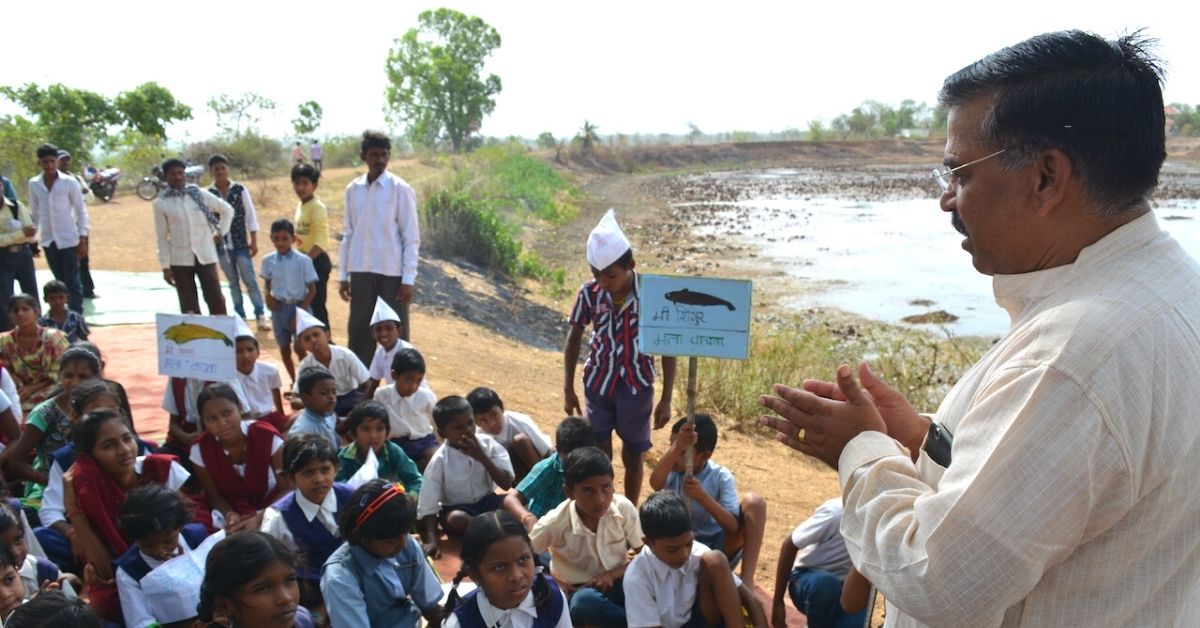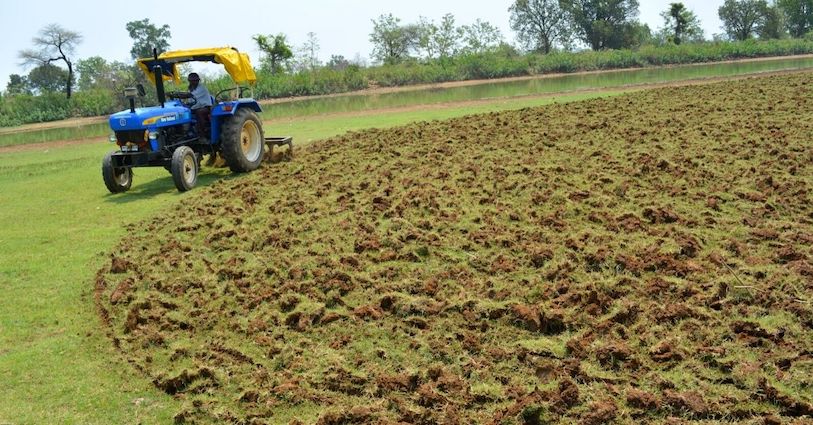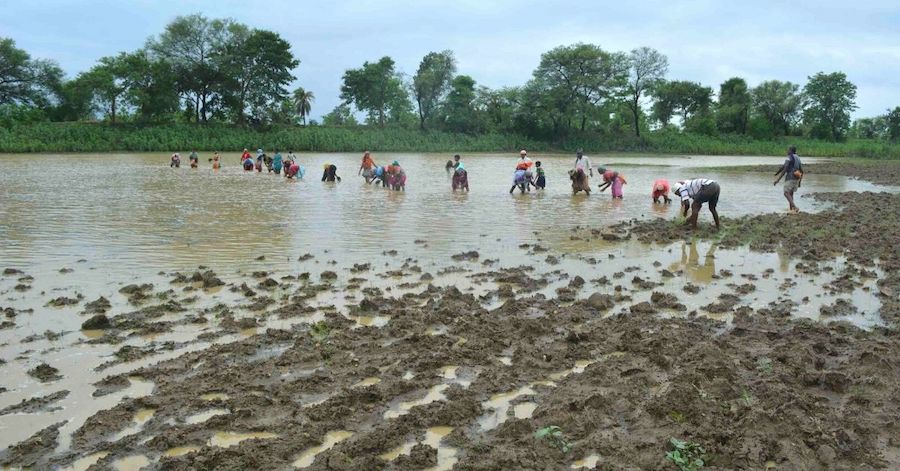Maharashtra Bird Watcher Singlehandedly Helps Revive 63 Lakes Across 43 Villages
Manish Rajankar in Bhandara and Gondia districts brought the tribal community together imbibing sustainability in their lives

A Pied Kingfisher diving into the water for a catch, a Heron swooping for fish and perhaps a low-flying Bronze-winged Jacana are some of the usual sights you may spot in lake Navtalab in Gondia district, Maharashtra.
It would be hard to believe now that just a few years ago, the lake was filled with overgrown weeds and was a dirty and deteriorating water body.
It is the efforts of Manish Rajankar, an avid birdwatcher and regular visitor, that condition of a dozen lakes in the area was transformed.
“There is a huge population of birds that visits these lakes but, it was disappointing to see the conditions of the lake constantly deteriorating,” Manish said.
Manish decided to understand the history and importance of the lake for the local community.
“The Vidarbha region houses many tribal communities like the Kohli, Teli, Kunbi, Sonar and other agricultural communities. They are also other communities such as Mahar, Gond, Dhivars and few more,” said Manish.
These people primarily fish and are involved in agricultural activities, and some of them also work as domestic help.

The formation of the Maharashtra state in the year 1960 also gave birth to fish co-operative societies where community members could use the water for irrigation, fishing and other purposes.
“Moreover, there was no control over the exploitation or even monitoring the health of water bodies known to exist since the 16th century. As per the 1901 gazetteer of Bhandara district, there were 12,000 lakes, and today there are about 2,700 lakes,” Manish said.
The bird watcher says it was his curiosity that led him to learn about the communities and earn a fellowship from a Pune-based mentor. “I learned the ecological, historical and socio-economic impact of these water bodies on the locals closely,” he added.
“With the introduction of non-native fish from the fisheries department, the native fish lost their importance and also the habitat. Agricultural practices involving pesticides and chemical fertilisers reached the water body and affected its biodiversity,” Manish said.
Non-native fish species like Grass carp, Pangasius pangasius, Cyprinus carpio, Anabas testudineus, Tilapia, Nilotica and Mossambicus got recorded during the study.
The bird watcher turned environmentalist also saw massive biodiversity loss during the de-silting of lakes under the Jalyukta Shivar scheme of the government in 2014, aimed at improving their water carrying capacity.

“The moves led to massive damage on the ecosystem, causing soil erosion, destruction of habitat and other losses of fish species,” he added.
Manish said discussions with the local communities during the study also revealed the loss of catch and the rapid disappearance of species.
The environmentalist then formed the Bhandara Nisarga Va Sanskriti Abhyas Mandal (BNVSAM), an NGO based in Arjuni Morgaon in Gondia district.
“We decided to find solutions to bring back the fish and habitat of the lake. The first thought was to remove the invasive weed and ensure the existing fish population do not get harmed,” he added.
Manish said the communities also decided to identify the native plant species in the surrounding lakes and replant them.
The task was carried out by ploughing the tank bed of the lake area during summer which usually gets submerged during monsoon.

Plants like Hydrilla verticillata, Ceratophyllum demersum, Vallisneria spiralis and floating plant species like Nymphoides Indicum, Nymphoides hydrophylla, Nymphaea cristata along with partly submerged plants like Eleocharis Dulcis got replanted.
“In 2009, we started with Navtalab (lake) in the area and planting native plant species. With a success of about 50-70 per cent that year, the people decided to introduce indigenous fish varieties from neighbouring Navegaon lake,” he told The Better India.
The environmentalist said some of the fish species saw reverse migration from the upstream water flow. “Slowly, the health of Nav-talaab improved and people living in the vicinity saw the difference,” he added.
Manish said eventually, each of the 12 fishing co-operatives in the two districts started approaching him to revive the lakes. “As of today, there are 63 lakes across 43 villages are being worked upon to improve their health,” he added.
Patiram Tumsare, a local from Dhivar community, said the efforts showed the number of local plant species thrived and also individual plants grew. “With enough food for fish and safe habitat, the catch increased. In Ghanod Gaon talab alone the fish catch increased from 98 kg to 630 kg, while in Motha Talav Arjuni the production increased from 120 kg to 249 kg,” he said.
Patiram said similar were the results in five other lakes were surveyed in the year 2016. “The fish population, native plants and birds visiting the area are monitored now,” he added.

Rakesh Patil, an Angler working towards the conservation of native fish Mahseer in Pune, said, “Grass carp, Pangus, Cyprinus carpio, Nilotica and Tilapia and Mozambique tilapia are all invasive species. Tilapia especially are highly invasive, and they have high fertility and adaptability.”
Explaining further Rakesh said the Anabus is mostly reported in South and East India as is reared for its medicinal value. “Also, it gets categorised as invasive as it can breathe and stay alive out of the water,” he added.
The expert said that carps are plant eaters, and like Rohu, grass carp and common carp species eat away the food of the plant.
“Fishers also buy tilapia, Indian Major Carp (IMC) seeds and fingerlings because they grow faster than local species,” he added.
However, Rakesh said that restoring the native biodiversity and habitat could be achieved and helps to protect the ecology in the long run. “The key is also to have separate water body to protect the native fish for pisciculture,” he added.
(Edited by Vinayak Hegde)
If you found our stories insightful, informative, or even just enjoyable, we invite you to consider making a voluntary payment to support the work we do at The Better India. Your contribution helps us continue producing quality content that educates, inspires, and drives positive change.
Choose one of the payment options below for your contribution-
By paying for the stories you value, you directly contribute to sustaining our efforts focused on making a difference in the world. Together, let’s ensure that impactful stories continue to be told and shared, enriching lives and communities alike.
Thank you for your support. Here are some frequently asked questions you might find helpful to know why you are contributing?


This story made me
-
97
-
121
-
89
-
167











